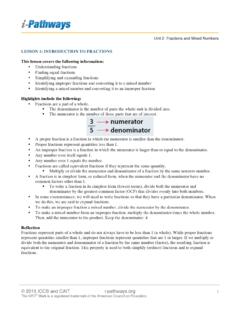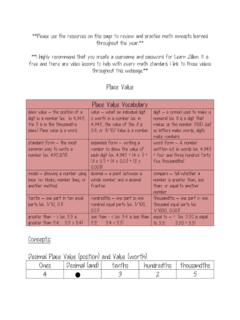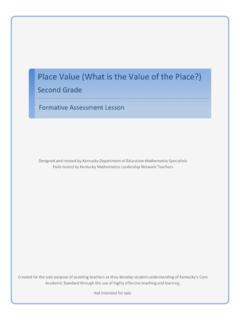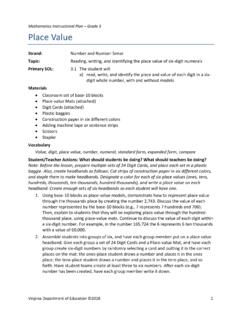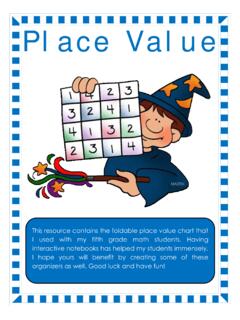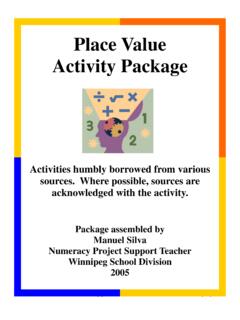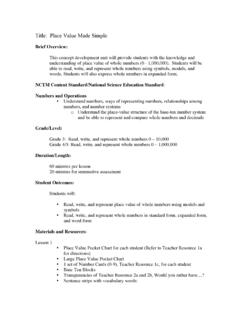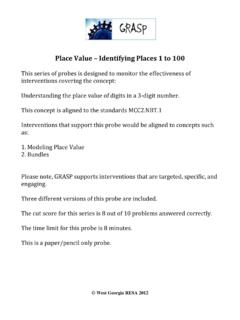Transcription of Whole Numbers – Place Value, Rounding and Estimates
1 Unit 1 Lesson 1 Whole Numbers Place value , Rounding and Estimates This lesson covers the following information: Identifying Place value of a digit Rounding and estimating Numbers Highlights include the following: You must know the value of Numbers In order to use Numbers correctly. Place value is the worth of a digit based on its position in a numeral. o Beginning with the ones Place at the right, each Place value is then multiplied by increasing powers of 10. o Zero holds the Place for a particular value when no other digit goes in that position. The most common way to write Numbers is in standard notation. Example: 203 Another way to write Numbers is in their English word equivalent. Example: two hundred three.
2 The least common way to write a number is in expanded notation. Example: 203 = 2 x 100 + 0 x 10 + 3 x 1 Rounding a given number means to find another number close to the given number . Numbers are rounded to make them easier to work with. Estimation allows you to determine if an answer is reasonable. Reflection: You learned Identify Place value of a digit in a number Round Numbers to a given Place value 2014 ICCB and CAIT 1 Estimate Numbers Notes: Word Search: Find all the words in the list. Words can be found in any direction. DECIMAL STANDARD NOTATION 2014 ICCB and CAIT 2 DIGIT SYSTEM EXPANDED NOTATION Whole number Place value R F U Q E S D H K R J S E H S E I R W U C E U R E L C T A B G R U P X S L Y K T D R B D Z N N Y P P S F L P L K O E N K X D W M G H R J O X I G A S Y S T E M L Y L L Q U L C J J Y P N V Z I V Z C T P T S A M F N B F N N D I E F L K D U F Z X B R V U I E K H E N V C W C U D L T E S M T P P M F L D F Z B A O X V A V M Q E H S L V S T N O R H A L D U M D Z W A O S X L A J O D L H I B P O I B X A P D I G V B Z T Z S K G W U Y C F P R R A F Q H Y U A J C V K B S Z E W U I B H W H N O I T A T O N D R A D N A T S X U O C D L I A N M S P Z I V U D D E
3 N V W A G A O I W H N K D F J G C U U R M Y R F T N A F O B H D U J R E I F S X V Q V Q P R Y A P J V N C G E U P T G E B W E J S O M Q V V Y O K J Y B N L V F V N P E M Y P V Y S X Z J Z Q M D G M D N E U E T O N S J L T N Q S G J G Q L C M Z M G M Practice Problems: Write the Place value of the underlined digit. 12257 _____ 2014 ICCB and CAIT 3 185081 _____ 591 _____ 1883 _____ 5466 _____ 5946 _____ 1043761 _____ 4072 _____ 39127 _____ 736225 _____ Identify the digit in the Place value . 5247 _____ thousands, _____ tens, _____ ones, _____ hundreds 2589 _____ thousands, _____ tens, _____ ones, _____ hundreds 9547 _____ thousands, _____ tens, _____ ones, _____ hundreds 3423 _____ thousands, _____ tens, _____ ones, _____ hundreds 5207 _____ thousands, _____ tens, _____ ones, _____ hundreds 6561 _____ thousands, _____ tens, _____ ones, _____ hundreds 2052 _____ thousands, _____ tens, _____ ones, _____ hundreds 7774 _____ thousands, _____ tens, _____ ones.
4 _____ hundreds Unit 1 Lesson 2 Whole Numbers Addition, Subtraction, Multiplication, and Division This lesson covers the following information: 2014 ICCB and CAIT 4 How to add, subtract, multiply, and divide Whole Numbers Understanding the special rules Highlights include the following: Addends are the Numbers being added. The commutative property of addition means that the order which the Numbers are added does not matter. Example: 7 + 5 = 5 + 7 The associative property of addition refers to grouping of Numbers . You can only add two Numbers together at a time before you add the third number . Example: 5+7+13 (5+7)+13 5+(7+13) The additive identity property means that any number plus zero is the original number .
5 Example: 106+0=106 Writing Numbers vertically helps make sure the Place values are lined up in columns. Example: 157+31188 When subtracting Numbers , write the Numbers vertically so the Place values are lined up in columns. Subtract only the digits with the same Place value . Example: 173 21152 Borrowing happens when the digit is smaller than the digit being subtracted. Factors are the Numbers being multiplied. The result of multiplication is the product. The commutative property of multiplication means the order which the Numbers are multiplied does not matter. Example: 2 x 3 = 3 x 2 Associative property of multiplication means that you can only multiply three Numbers , you can only multiply two at a time. Zero factor law means that any number times zero is zero.
6 In division, you find out how many times one number is contained in another. Reflection: You learned how to add, subtract, multiply, and divide Whole Numbers . You learned addition 2014 ICCB and CAIT 5 properties. You learned the multiplication properties necessary to move to the next step as well! Now you are ready to apply these skills to solve word problems. Use this table as a way to study multiplication facts. Notes: Word Search: Find all the words in the list. Words can be found in any direction. 2014 ICCB and CAIT 6 ADDENDS DIFFERENCE DIVIDEND DIVISION DIVISOR FACTORS MULTIPLICATION PRODUCT QUOTIENT REMAINDER SUM Whole number W D D N F F F S M J E H R I I D N K F Q H Q I L O G B D U C X E U O Y J J N U X A Z V V M I F Z N T H R G E S R W O T Q S J I M I X T E I C F G W X S I T L R T R U D L D S R A K D Y K K V D I V I L N O Q E J A E I R C P H E C I E M M I O R T X N D F Q Z O C I F U S N T P W N D E C W D F O C U G N C L S T C K G M H N B A I I S D N E D D A F P U V N F J B X M F D Y O P Z S S C B F D I G J N E S I U U Z H S U Y U F I I O Z A T C Y X H O N Y Q B P X E P R V R V M B B L J K Q Q E C C H Q L K P F P K R N G X M U
7 P D N L I C O L A W D R X V O K O J S Y M Q N O H H D L N U P N F F X D Y Q D F T K P H S P F L L T T B G R E D D A I R C T P W M S W T W J Z K G O M Y R K T W Y P P G H J D H J V U J I Q M G F T F M P K T F N T V Z N C E B C Y E X K X P Q C G R J S U M J H F C N H G R E M A I N D E R G Practice Problems: 2014 ICCB and CAIT 7 1. Jason wanted to eat healthier and decided to buy fruit and vegetables at the grocery story. He spent $ for a bag of apples, $ for a large box of oranges, $ for 3 pounds of green beans. He paid the clerk with a $ How much change will Jason receive? _____ 2. Jolene treated 5 of her friends to a night out at the baseball game. She bought 3 hotdogs, 2 servings of nachos, and 4 pizzas.
8 Each of the items cost $ How much did she pay for all the food? _____ 3. A hostess of a birthday party bought 6 pizzas with 8 slices each. There were 5 children and together they ate 15 slices of pizza. How many slices were left? _____ 4. A group of 8 friends entered the 30-Day Push-Up Challenge. Each day, they did 10 push-ups. How many push-ups were completed during the challenge? _____ 5. There are 365 days in one year. How many days are in 14 years? _____ 6. The local adult education program has classes at 7 different locations. Each location has 2 classes, one during the day and one during the evening. There are 12 students in each class. How many students are involved in the adult in the adult education program? _____ 7.
9 Mr. Johnson has a field trip planned for the children who attend his community center where he will supervise one group. There are 256 children who want to attend the trip. Mr. Johnson needs 31 adults to help. Each adult will supervise one group. How many children will be in each group? _____ 8. A fruit farm packs apples in boxes that hold 10 apples each. One day, 2650 apples were packed. How many boxes were used? _____ 9. Kendall has been collecting coins since he was 8 years old. He decided to cash in his change. He discovered there were 4380 pennies. How many dimes would this be? _____ 10. You want to plan a fundraiser. The expenses are $ Your goal is to earn $ profit. How many tickets would you need to sell at $ each? _____ Unit 1 Lesson 3 Whole Numbers Mean, Median, Mode and Range 2014 ICCB and CAIT 8 This lesson covers the following information: How to define mean, median, mode, and range.
10 How to solve math problems involving mean, median, mode, and range Highlights include the following: The mean of a set of Numbers is the average. In order to find the mean, add all the Numbers and then divide the sum by the total Numbers of items. The median is the exact middle number in a group of Numbers . If there is an even number of items in the data set, add the two middle Numbers and then divide by 2. The mode of a set of data is the value in the set that occurs most often. Not every set of Numbers has a mode. Some sets may have more than one mode. The range is the difference between the highest and lowest values in a set of Numbers . Reflection: The mean, median, mode and range are measures of central tendency that describes a set of data.


